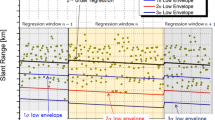Abstract
Generally, a ground telemetry station for a launch vehicle (LV) includes a tracking function only; therefore, position measurements for LV depend on received navigation data from on-board systems of LV or depend on estimated position from ground radar system in real time. Time of arrival (TOA) and angle of arrival (AOA) are typical location techniques for emitting targets. In this study, we propose a virtual on-board timer to estimate TOA for LV and verify its localization performance using Combined TOA and AOA localization method. For real time processing, the proposed virtual on-board timer should be created at space center and distributed to remote stations before lift-off of LV. By comparing the time stamp of the virtual on-board timer and received time, TOA and its corresponding slant range can be estimated. In order to combine the estimated TOA and AOA, we create sphere equations with the estimated range radius and vertical plane equations, to include unit vectors for the AOA direction. By solving these equations, a three-dimensional (3D) target point can be obtained. We confirm localization performance of the estimated TOA by comparing with an on-board GPS of 3rd KSLV-1 mission in January 2013.














Similar content being viewed by others
References
Chan, Y.-T., Yau Chin Hang, H., & Ching, P. (2006). Exact and approximate maximum likelihood localization algorithms. IEEE Transactions on Vehicular Technology, 55(1), 10–16.
Zhaounia, M., Adnan Landolsi, M., & Bouallegue, R. (2010). Hybrid TOA/AOA approximate maximum likelihood mobile localization. Journal of Electrical and Computer Engineering. https://doi.org/10.1155/2010/942657.
Parkinson, B. B. W., Spilker, J. J., Axelrad, P., & Enge, P. (2010) Global positioning system: Theory and applications. In Progress in astronautics and aeronautics, vol. 2. American Institute of Aeronautics and Astronautics.
Tao, J., & Buehrer, R. M. (2008). A new Cramer-Rao lower bound for TOA based localization. In: 2008 Military communications conference, pp. 1–5.
Bialer, O., Raphaeli, D., & Weiss, A. J. (2012). Efficient time of arrival estimation algorithm achieving maximum likelihood performance in dense multipath. IEEE Transactions on Signal Processing, 60(3), 1241–1252.
Chen, L., Julien, O., Thevenon, P., Serant, D., Garcia Peña, A., & Kuusniemi, H. (2015). TOA estimation for positioning With DVB-T signals in outdoor static tests. IEEE Transactions on Broadcasting, 61(4), 625–638.
Khan, M. W., Salman, N., & Kemp, A. H. (2014). Enhanced hybrid positioning in wireless networks I: AoA-ToA. In: 2014 International conference on telecommunications and multimedia (TEMU), pp. 86–91
Peng, R., & Sichitiu, M. L. (2006). Angle of arrival localization for wireless sensor networks. In 3rd Annual IEEE Communications Society on Sensor and Ad Hoc Communications and Networks (Vol. 1, pp. 374–382).
Boyd, S., & Vandenberghe, L. (2009). Convex optimization. Cambridge: Cambridge University Press.
Jeong, S., Sung, T.-K., Eog Lee, K., & Kang, J. (2014). Joint TOA/AOA-based localization in wireless sensor networks. In: 2014 IEEE 8th international conference on signal processing and communication systems (ICSPCS).
Sun, Y., Zhou, Z., Tang, S., Ke Ding, X., Yin, J., & Wan, Q. (2016). 3D hybrid TOA-AOA source localization using an active and a passive station. In: 2016 IEEE 13th international conference on signal processing (ICSP).
Shang, F., Champagne, B., & Psaromiligkos, I. (2014). Joint TOA/AOA estimation of IR-UWB signals in the presence of multiuser interference. In: 2014 IEEE 15th international workshop on signal processing advances in wireless communications (SPAWC).
Acknowledgements
This research was supported by the Space Center Development Project II and the ITRC (Information Technology Research Center) support program (IITP-2016-R2718-16-0011) supervised by the IITP(Institute for Information and communications Technology Promotion) of the MSIP (Ministry of Science, ICT and Future Planning), Korea. This research was supported by Basic Science Research Program through the National Research Foundation of Korea(NRF) funded by the Ministry of Education(NRF-2015R1D1A1A01059397). This study was financially supported by Korea Aerospace Research Institute (KARI) and Chonnam National University (Grant Number 2016-2503).
Author information
Authors and Affiliations
Corresponding author
Additional information
Publisher's Note
Springer Nature remains neutral with regard to jurisdictional claims in published maps and institutional affiliations.
Rights and permissions
About this article
Cite this article
Kwon, S., Kim, D., Lee, J. et al. 3D Localization for Launch Vehicle Using Virtual TOA and AOA of Ground Stations. Wireless Pers Commun 102, 507–526 (2018). https://doi.org/10.1007/s11277-018-5855-6
Published:
Issue Date:
DOI: https://doi.org/10.1007/s11277-018-5855-6




